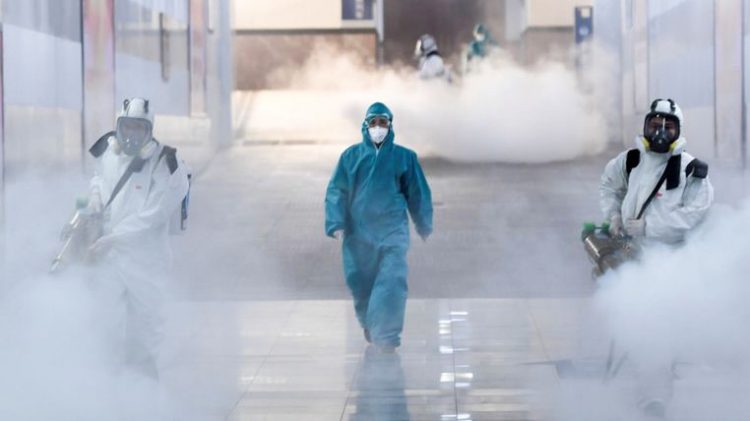— In U.S. A., 3 new coronavirus cases confirmed in California and 1 in Massachusetts, in addition to previous 7 in California, Washington and Illinois, bringing total to date to 11 confirmed Wuhan coronavirus cases. 3 ill patients now at NYC hospitals might have the coronavirus since all had recently visited mainland China.
— The U. S. has issued the highest “Level 4” travel advisory to not travel to China at all.
— U.S. citizens, permanent residents and immediate family, who have visited China’s Hubei province where Wuhan is the capital, must now undergo a mandatory two-week quarantine.
— W. H. O. reports 27 cases of person-to-person coronavirus have spread in 9 countries beyond China.


“This Wuhan coronavirus is very, very transmissible, and it almost certainly is going to be a pandemic. But will it be catastrophic? I don’t know.”
— Dr. Anthony Fauci, Director of the National Institute of Allergy and Infectious Disease,
“This looks far more like H1N1’s 2009 swine flu spread than SARS, and I am increasingly alarmed. Even 1% mortality would mean 10,000 deaths in each million people.”
— Dr. Peter Piot, Director of the London School of Hygiene and Tropical Medicine
“Knock-on effects for the global economy are going to be much larger than they were for SARS.”
— Nicholas Lardy, China expert, Peterson Institute for International Economics, Washington, D. C.
Feb. 4th 10 AM Mtn UPDATE Albuquerque, New Mexico – The Wuhan coronavirus has now killed 427 people, including two outside China. The new virus is spreading rapidly like influenza and has now infected more than 20,000 people in China and 28 other countries. These numbers are greater than the SARS threat in 2002-2003. China also faces how to sustain food supplies for its 1.4 billion people.
Dangerous 104 degree F. fevers common.The first death outside China was reported Sunday, February 2, 2020. A 44-year-old man in the Philippines died of “severe pneumonia” infection by the coronavirus, the first death of the rapidly spreading disease outside China. His name has not been released by Chinese authorities, but he was a resident of Wuhan, China. He had recently traveled from Wuhan to be with a 38-year-old woman in the Philippines. Only hours before his death, the Philippine government reported a temporary ban on non-Filipino travelers who traveled from mainland China, Hong Kong and Macau.
The second death outside China on February 2, 2020, was a 39-year-old man in Hong Kong. The Hong Kong Centre for Health Protection said the man had an underlying illness before being diagnosed with the coronavirus and had traveled to Wuhan on January 21, 2020.
Will Wuhan Coronavirus Accelerate from China Epidemic to World Pandemic?
Many of the world’s leading infectious disease experts are now asking the question: Is this China epidemic headed around the world in a pandemic, defined as disease spread to at least two continents?
Dr. Anthony Fauci, Director of the National Institute of Allergy and Infectious Disease, compares the Wuhan coronavirus to spreading more like influenza from coughs, sneezes and touching. “This Wuhan coronavirus is very, very transmissible, and it almost certainly is going to be a pandemic. But will it be catastrophic? I don’t know.”
Dr. Peter Piot, Director of the London School of Hygiene and Tropical Medicine, warns, “This looks far more like H1N1’s 2009 swine flu spread than SARS, and I am increasingly alarmed. Even 1% mortality would mean 10,000 deaths in each million people.” TNYT reports that “at least four African countries have suspect cases quarantined. Africa has more than 1 million expatriate Chinese workers there.”
Fears of An Impending Worldwide Economic Shock
On February 4, 2020, the car manufacturer Hyundai has announced it is suspending production lines at its factories in South Korea. Apple, Starbucks and Ikea have closed stores in China, at least temporarily, as the number of Wuhan coronavirus infections keep rising rapidly. Most American airlines that were traveling to and from China have stopped altogether.
So many international companies in this 2020 world have depended upon Chinese factories, including Wuhan, to make parts for a large variety of products. Compared to the SARS pandemic in 2002-2003, China suffered months of economic contraction. “Knock-on effects for the global economy are going to be much larger than they were for SARS,” says Nicholas Lardy, a China expert at the Peterson Institute for International Economics in Washington, D. C.
Ben May, a global economist at Oxford Economics in London, told TNYT: “If you run out of widgets that are essential to production processes and all those widgets come from China, then it may well be that your production lines go to a halt. These problems are likely to be popping up all over the world.”
More Information:
03-21-2006 – One Way H5N1 Bird Flu Could Adapt to Humans
03-10-2006 – The Rapid Spread of H5N1 Bird Flu Virus
10-26-2005 – H5N1 Bird Flu – The Next Pandemic?
04-14-2003 – SARS Breakthrough – Genetic Sequencing of Coronavirus Linked to Killer Pneumonia
https://www.who.int/ihr/procedures/novel-coronavirus-2019/en/
© 1998 - 2024 by Linda Moulton Howe.
All Rights Reserved.

